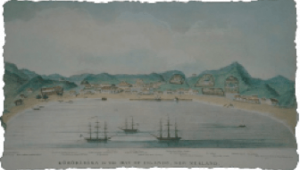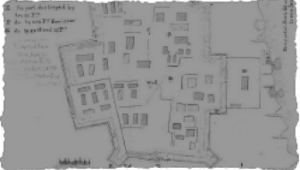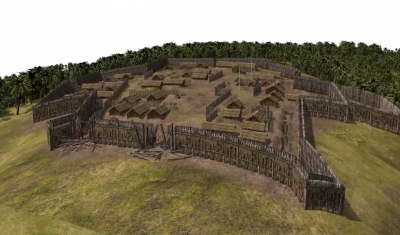
Pre-musket
Māori Pā (Fortifications)



There are at least 5000 pā in New Zealand, a great many of them in Northland. Some of them, like Ruapekapeka, are “gun-fighter” pā, built after the arrival of the Europeans and especially adapted to face an enemy armed with muskets and artillery. The vast majority, however, were built during a period of 300 years or so, commencing at about 1500 AD1. It is worth considering the nature and function of Māori pā of old, to better understand their more recent derivatives.
Traditional pā were fortified positions designed to thwart an attacking force with a mix of earthworks, palisades and excellent natural defences. These pā were designed to defend against war parties armed with short clubs of wood, bone or stone, longer wooden weapons, and spears of several different varieties. In the absence of projectile weapons, an elevated position, sheer cliffs, steep slopes, and a narrow access way were excellent natural defences.
By the end of the 18th century, most communities in northern New Zealand maintained at least one pā in a state of readiness. Some pā were also substantial villages and home to sizable populations. Others functioned more like refuges or fortified food stores. The people would live in a kainga close by, and use their pā for ceremonial reasons or for shelter when an attack was imminent.
Most pā had houses and food storage facilities within the defences. Early European missionaries record pā containing one hundred or two hundred houses, but most pā would have had far less accommodation than that. Some of the so-called “houses” were actually covered food-storage pits. Food, especially kūmara, was often stored inside the defences of the pā. There were two reasons for this: to protect the invaluable winter food supply and to provide sustenance in case of a siege.
Pā were built on carefully chosen locations, most often near the coast, on headlands, in harbours, or on hill near a river or estuary. Ditches, banks, palisades and fighting platforms were built to enhance the natural defences. The Station Bay pā on Motutapu, an island in the Hauraki Gulf, is an excellent example of a headland pā. At Station Bay, the headland is cut off from the mainland with a wide and deep defensive ditch. Enhanced with heavy-duty palisades, the defensive ditch would have posed a formidable barrier for an attacking war party. Like many pā, the one at Station Bay possessed multiple lines of defence. There were two more defensive ditches and artificially steepened scarps, dividing the interior of the pā into separate zones. If the attackers broke through the outer trench and palisades, the people inside could withdraw into a succession of defensive positions.
[IMAGE ADAPTED FROM FOX] shows a defensive ditch, palisades and fighting stage. It is easy to see how a small group of defenders could hold off a much larger war party. A direct attack would require the warriors to pull or cut down the sturdy palisades, while the defenders stabbed at them through gaps at ground level. From banks or fighting stages above the defenders could through rocks or spears at the warriors trying to get in. Not surprisingly, a war party would often try less direct methods of getting inside the pā of their enemy. Setting the pā alight was one way of doing it, although that tactic could (literally) backfire if the wind changed. Subterfuge was another way of gaining access. For example, an approaching war party might gather up large bundles of fern and impersonate a group servants returning to the pā after work. A similar tactic was to approach the pā pretending to be friendly visitors.2




